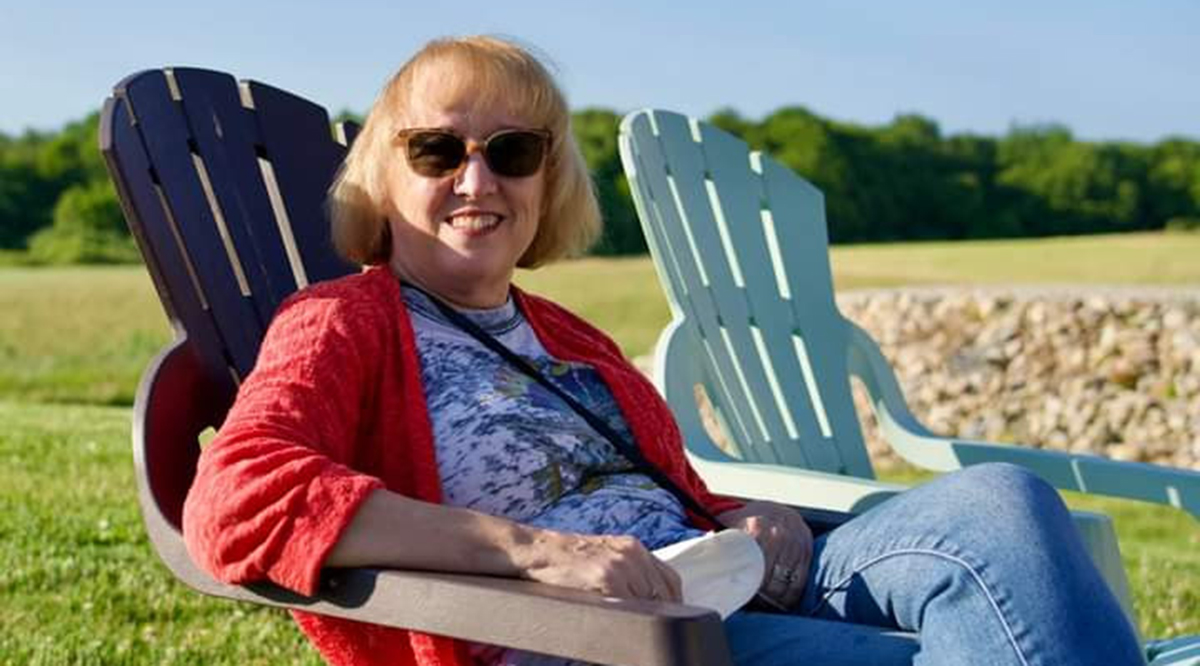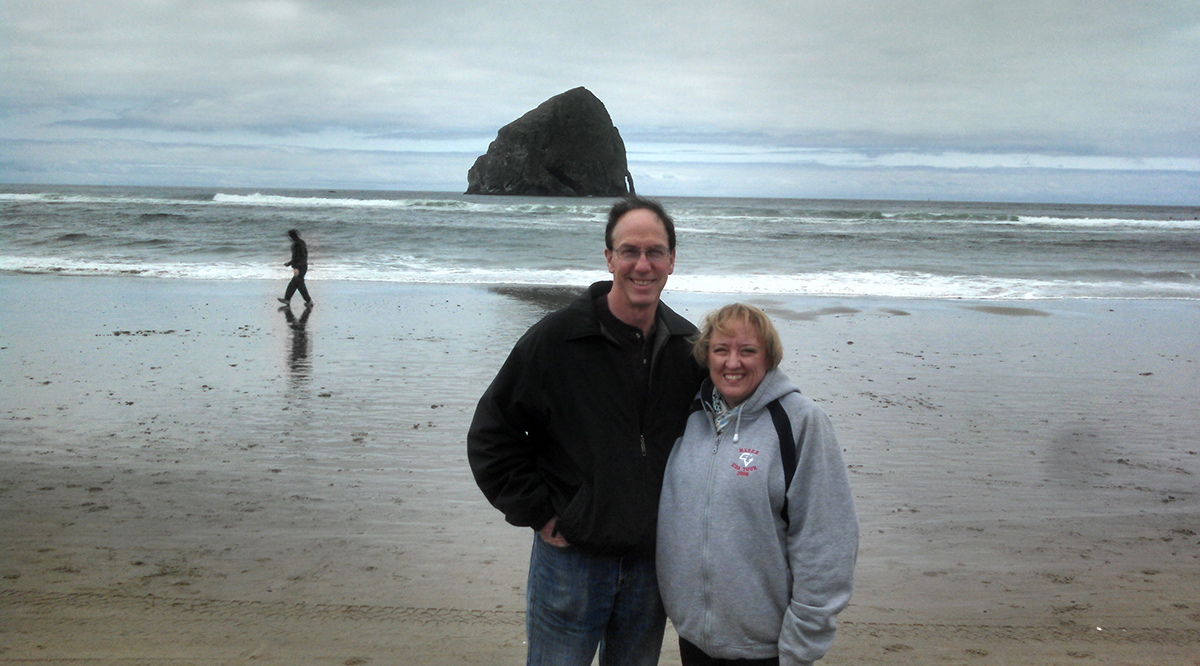
A few years ago, Lori Weiss, a high school math and engineering teacher, noticed it was taking her longer to do her lesson plans and grading. She also repeatedly needed to ask for help using spreadsheets she’d once mastered and she struggled to answer her students’ questions.
The symptoms were all too familiar to Weiss. Not only had she cared for her grandfather with Alzheimer’s disease when she was a teenager, she’d also watched her mother slowly lose her memory to the disease for nearly two decades. She had aunts, uncles, and a cousin as well who were diagnosed with the neurological disorder, which gradually steals a person’s memory and cognitive abilities.
“It’s rampant in my family,” Weiss says.
Weiss decided to speak with her primary care physician, who referred her to a neurologist for testing. In 2020, at the age of 62, Weiss was diagnosed with mild cognitive impairment. Two years after that, a PET scan revealed amyloid plaques, a buildup of toxic proteins in the brain that disrupt neural function and are a hallmark of Alzheimer’s disease.
Soon, Weiss began to lose her sense of direction, which prompted fears that she might be forced into a full-time care facility at a young age.
“Losing my freedom was just more than I could handle,” she says. Around that time, a friend saw a TV advertisement for a clinical trial for a drug that would attempt to slow progression of the disease using manmade monoclonal antibodies to attack and remove the amyloid plaques in the brain.
“I don’t even think that I thought twice about” enrolling in the trial, says Weiss, who has been receiving monthly infusions of the drug, called donanemab, near her home in Portland, Oregon, for about a year. “I just said, ‘Yeah, sign me up!’”
Although donanemab is not approved by the Food and Drug Administration (FDA), it uses a similar approach to the drug lecanemab, which received accelerated FDA approval on Jan. 6, and which showed biological and clinical benefits for patients in trials. In November, drugmaker Eli Lilly and Company announced promising results for donanemab, but last week, the FDA denied the company’s request for accelerated approval, saying it needed more data for participants receiving the drug for at least 12 months.
Nonetheless, this recent progress has given people like Weiss hope that previous generations have not had.
“Alzheimer’s research is getting to a place where cancer research was maybe 30, 40 years ago.”
Anton Porsteinsson, MD, University of Rochester Medical Center in New York
Participating in the clinical trial “has had a huge impact,” Weiss says. “It’s given me the drive to do things while I can; it’s given me the desire to talk to more people about getting treatment, getting diagnosed early, and getting in drug trials.”
Weiss says that since she’s begun taking donanemab, she’s regained her sense of direction and has not noticed significant cognitive decline. For her, even the hope that the trial has given her has made all the difference.
“For my husband and I, it’s totally changed our lives. Instead of living in fear … we treat each day like it’s Valentine’s Day,” Weiss says. Getting diagnosed early has “given me so much more life. [I thought] getting the disease was a death sentence for me, but I’m taking a water painting class, I’m in a walking group and a music group. I thrive on my relationships with my Alzheimer’s friends and other friends, and I’m connected with my family. I feel like I’m living my life. It’s so much better than I imagined.”

And while Alzheimer’s researchers are careful to emphasize that they are still a long way from a cure, many say the hope is not a false one. The field has had several breakthroughs in recent years, from identifying easier and cheaper ways to diagnose the disease early to better understanding how individuals with the disease might require a variety of interventions.
“Alzheimer’s research is getting to a place where cancer research was maybe 30, 40 years ago,” says Anton Porsteinsson, MD, director of the Alzheimer’s Disease Care, Research and Education Program at the University of Rochester Medical Center in New York. “I think we’re at a point where we’re going to see a logarithmic increase in discovery.”
Fighting a complex disease
Alzheimer’s disease, which was discovered in 1906 and is now the seventh leading cause of death in the United States, has long boggled the scientific community. Though research over the decades has identified characteristics of the disease — such as the presence of amyloid plaques between neurons and the buildup, known as tangles, of another toxic protein, tau, inside neurons — questions remain about what causes the disease and how best to treat it in a clinically meaningful way.
“It’s a complex disease. It’s not just a single molecule that’s gone awry. It’s not an infection that has a viral particle,” says Ronald C. Petersen, MD, PhD, director of the Mayo Clinic Alzheimer’s Disease Research Center in Rochester, Minnesota. “We’ve defined it by the presence of amyloid, neuritic plaques, and neurofibrillary tangles, but that’s just the tip of the iceberg.”
Many researchers now believe that the precursors to developing Alzheimer’s begin to accumulate in the brain 10 or more years before symptoms begin to show.
Alzheimer’s disease progression affects the brain much like a forest fire, with many factors affecting how it spreads, says Rudolph E. Tanzi, PhD, director of the Genetics and Aging Research Unit at Massachusetts General Hospital in Boston.
Amyloid plaques and tau tangles can build up over years, at some point triggering an inflammatory response that can quickly destroy brain cells. These conditions can be influenced by a range of factors, from genetic predisposition to environmental exposures to lifestyle, he explains.
That’s why the solution to treating — or ideally, preventing — Alzheimer’s disease will likely require a combination of interventions, Petersen says.
One important part of the puzzle — and a part that has been the focus of much pharmaceutical development — is targeting the amyloid plaques.
This approach has been controversial. In 2021, the FDA granted accelerated approval to the anti-amyloid drug aducanumab, sold as Aduhelm, despite objections from an advisory committee and outcry from the scientific community that the lack of clinical benefit made the drug’s high cost, initially set at $56,000 a year and later reduced to $28,000 a year, unjustifiable. A Congressional investigation found numerous flaws and irregularities in the process the FDA used when approving the drug.
Lecanemab, on the other hand, has been met with more optimism in the Alzheimer’s research community because its clinical trials demonstrated an actual clinical benefit to patients early in the disease progression.
“The field is feeling that, finally, we have a drug that didn’t have the controversy aducanumab had,” Petersen says. “It looks like it does what it’s supposed to do biologically [and] this looks like it could be meaningful for patients.”
In clinical trials, lecanemab showed a modest but tangible decrease in cognitive decline (of 27%) over 18 months in Alzheimer’s patients who were early in the disease’s progression, compared with patients who were given a placebo. Though it’s far from a cure, experts say it could give patients months of retaining memory and cognition that they might otherwise lose, a prospect that could be meaningful for patients and their families who have no other options.
But this drug, too, has stirred some controversy because of its high price tag and potentially deadly side effects, including swelling and bleeding in the brain. The pharmaceutical company Eisai has priced lecanemab, sold as Leqembi, at $26,000 a year, and the Centers for Medicare and Medicaid Services has yet to decide if it will cover the drug.
“It’s very expensive,” Tanzi says, explaining that patients who take the drug will also need several MRIs to check for brain bleeds on top of the cost of the infusions. “There is a health care disparity this could create; those who want to remove amyloid can pay out of pocket [but] the average person can’t afford that. The wealthy can protect themselves.”
Equity starting in research
The high costs of treatment could also exacerbate existing racial disparities when it comes to Alzheimer’s outcomes. Although Black Americans are about twice as likely as White Americans to have Alzheimer’s, and Hispanics are about 1.5 times as likely to have it, White people make up a disproportionate majority of clinical trial participants and non-White people report greater barriers to diagnosis and access to care, according to the Alzheimer’s Association.
“Most of the research operations are either based at large academic institutions or private professional research sites,” Porsteinsson explains about pharmaceutical company trials. “The temptation [for researchers] is to go where the treatment is ‘easiest’; where you’ve recruited before.”
In its clinical trial recruitment for lecanemab, the University of Rochester succeeded in increasing the representation of Hispanic participants, but struggled to include a representative number of Black patients.
“We can’t just wait until the brain deteriorates.”
Rudolph E. Tanzi, PhD, Massachusetts General Hospital in Boston
“If we want to go after historically underrepresented groups in research, first we need to recognize they’re underrepresented for a reason,” Porsteinsson says. “There might have been a poor experience with researchers coming [into their community], doing a study [the researchers] needed, and then basically leaving. There isn’t an ongoing commitment.”
He says that if Alzheimer’s treatments are going to be meaningful to all people affected by the disease, it will take a concerted effort to include more diversity in clinical trial participants, not only in race and ethnicity, but in health status and inclusion of people with comorbidities. Often, trials tend to select for the healthiest patients possible, he explains.
“[We must] secure making our research more representative of the American population,” Porsteinsson says. “It’s going to take an investment in infrastructure and it’s going to take an investment of time.”
A stage set for discovery
Alzheimer’s disease already affects more than six million people living in the United States, and that number is projected to grow to 13 million by 2050. It’s also an incredibly financially costly disease, with an economic impact of $321 billion in health care costs in 2022, expected to rise to $1 trillion by 2050, according to the Alzheimer’s Association. That prospect prompted the U.S. Congress to approve an additional $226 million to the National Institutes of Health for Alzheimer’s research in December, bringing the annual federal funding outlay to more than $3.7 billion.
Experts say it is not in vain. Research efforts, particularly those at teaching hospitals, have helped unlock mysteries about the genetic underpinnings of the disease, ways to identify biomarkers in the blood that can more easily diagnose the disease in its earliest states, and complex treatment approaches that use lifestyle interventions and a combination of drug therapies.
Tanzi believes that the future of Alzheimer’s treatment and prevention will be similar to current management of heart disease and diabetes. It could mean more regular screenings and early interventions, such as taking anti-amyloid drugs and incorporating lifestyle and diet changes before the disease gets out of control. And for those already diagnosed, it means using a combination of therapies that target different aspects of the disease, such as neuroinflammation and plaque buildup.
“We can’t just wait until the brain deteriorates,” he says.
With the current momentum, Porsteinsson hopes that young and aspiring physician-scientists will be inspired to join the field and continue the research for generations to come.
“What many medical students and young doctors have historically been hesitant about is that dementia is very nebulous, there is a lot of gray there. … They felt things were pretty bleak, too uncertain, and there was too little you could offer,” he says. “Now, I think we are at the dawn of a very different era.”
